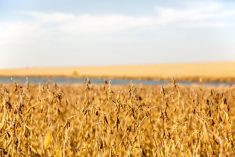A damaging soybean pest that was expected to show up sooner or later in agricultural Manitoba has officially arrived.
Crop surveys by University of Manitoba Ph.D. student Nazanin Ghavami with soil science professor Mario Tenuta and his students have turned up soybean cyst nematode at “extremely low” levels on soybean plant roots in one field in each of four south-central municipalities: Norfolk-Treherne, Rhineland, Emerson-Franklin and Montcalm.
According to Manitoba Pulse and Soybean Growers in a statement Monday, the pest, a microscopic-sized roundworm, was identified by visual and molecular DNA methods in four out of 106 sampled fields across 18 municipalities. Select fields have been sampled and surveyed in Manitoba’s soy-growing regions since 2012.
Read Also

Selling GMO tomato seeds to Canadian gardeners ‘reckless’ say advocates
Selling genetically-modified purple tomato seeds to home gardeners could raise the risk of contamination of organic vegetable varieties and hamper farmers’ ability to save their own seed, say a group of advocates.
Tenuta, in a paper released Monday, noted economical levels of crop damage weren’t observed in any of the four fields with the pest. The low levels are consistent with “recent establishment” rather than a long-undetected problem.
Already confirmed in soy-growing areas of Ontario, Quebec, North Dakota and Minnesota, soybean cyst nematode feeds on soybean roots, causing yellowed leaves, stunted plants and yield loss. Once established in a field, it can remain in the soil for many years.
Cysts were found in the four fields in question during the 2017 survey and later confirmed by DNA tests to be those of the soybean cyst nematode, at “extremely low” levels of two, one, 14, and 14 cysts per five pounds of soil.
Positive fields were resampled in May this year and two were confirmed as having cysts, at levels of two and 20 per five pounds of soil. The field with cysts at the higher level, which was planted to soybeans this year, was visited again in August and found to have cysts on roots consistent in appearance with soybean cyst nematode, Tenuta wrote.
To put the Manitoba cases in perspective, cyst levels in areas of Ontario and the U.S. Midwest where the nematode has been present for “many decades” can be as high as 3,000 to 4,000 per five pounds of soil.
That said, given the “large gap” between the host municipalities with positive identification, “there is a possibility that (the nematode) may be present in fields that were not included in the survey, or may have established since sampling of a field has occurred.”
The Manitoba field in question had “no visible disease symptoms indicating damage from the nematode” such as stunting, poor canopy closure or chlorosis, Tenuta wrote.
The pest’s arrival in Manitoba fields can “still be avoided by preventing the spread of soil from one field to another,” MPSG said in its statement.
Furthermore, soybean growers should consider rotating with non-host crops for two to three years — and, in municipalities with positive cases, using resistant soybean varieties.
Populations of soybean cyst nematode can also be “minimized” by rotating growing cover crops, reducing tillage and controlling host weed species, the grower group said. — Glacier FarmMedia Network
















